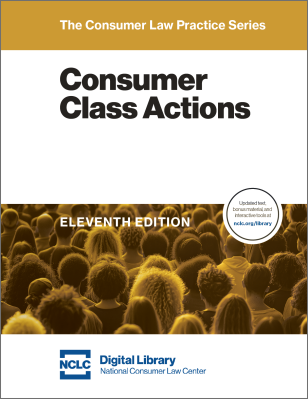It is increasingly likely that cases currently awaiting decision before the Supreme Court will be decided by eight justices. Two of the cases argued last fall and now awaiting decision could have dramatic impacts on consumer law and class action practices, and this article describes the implications if those cases result in a 4 to 4 tie.
Spokeo v. Robins Described
Spokeo v. Robins is a Fair Credit Reporting Act (FCRA) case with far-reaching potential consequences for class actions and Truth-in-Lending and many other consumer statutes. The Supreme Court is considering "Whether Congress may confer Article III standing upon a plaintiff who suffers no concrete harm, and who therefore could not otherwise invoke the jurisdiction of a federal court, by authorizing a private right of action based on a bare violation of a federal statute." The outcome would have significant impact on all consumer laws that provide for statutory damages without proof of actual injury.
In Spokeo the consumer alleged that the website operator, Spokeo Inc., willfully published inaccurate information about him, violating the FCRA, describing him as holding a graduate degree and as wealthy, both of which were untrue. The unemployed consumer alleged the misinformation caused actual harm to his employment prospects and that remaining unemployed had cost him money as well as caused “anxiety, stress, concern and/or worry about his diminished employment prospects.”
The district court ultimately dismissed the case, ruling the consumer had failed to allege an injury in fact and that any injuries pled were not traceable to Spokeo’s alleged violations. The consumer appealed to the Ninth Circuit, arguing that he alleged FCRA violations and since the FCRA provisions are enforceable through a private right of action, they create statutory rights that he has standing to vindicate in court. Spokeo, however, contended that the consumer cannot sue under the FCRA without showing actual harm despite the fact that the FCRA does not require a showing of actual harm when a plaintiff sues for willful violations.
The Ninth Circuit noted that when the statutory cause of action does not require proof of actual damages, a plaintiff can suffer a violation of the statutory right without suffering actual damages. Since Article III limits the power of Congress to confer standing, the issue in the case was whether violations of FCRA statutory rights are concrete, de facto injuries that Congress can recognize under the Constitution. The Ninth Circuit found, on the pleadings, that the consumer alleged that Spokeo violated his statutory rights and was among the “injured”; and that the interests protected by the statutory rights were sufficiently concrete and particularized that Congress fulfilled Article III’s injury-in-fact requirement.
If Spokeo v. Robins Ends in a 4 to 4 Tie
The Supreme Court can still conduct business even with only a six member quorum. If Spokeo results in a 4-4 tie, the Ninth Circuit ruling would be upheld, but would not be precedential. The Ninth Circuit ruling would stand allowing the consumer to go back to the district court to argue the case.
Most importantly, there would be no Supreme Court ruling requiring concrete harm to invoke a statute, and plaintiffs could continue to seek statutory damages for violations of statutes even where no actual damages are proven. Of course, another circuit court could rule to the contrary, but no circuit court has ruled in this manner to date. See generally the online version of NCLC’s Consumer Class Actions § 4.3a.
Tyson Foods v. Bouaphakeo Described
In Tyson Foods v. Bouaphakeo the Supreme Court certified two questions (1) whether differences among individual class members may be ignored and a Rule 23(b)(3) class action certified where liability and damages will be determined with statistical techniques that presume all class members are identical to the average observed in a sample and (2) “Whether a class action may be certified or maintained under Rule 23(b)(3) when the class contains hundreds of members who were not injured and have no legal right to any damages.”
The plaintiffs, employees of Tyson Foods, sued Tyson for not paying wages due. To calculate the employees’ compensable working time, Tyson measures when the employees are at their working stations and the production line is moving. The employees claim Tyson failed to include compensation for donning and doffing personal protective equipment and clothing.
Plaintiffs proved liability and damages by using individual timesheets, along with average donning, doffing and walking times calculated from a sample of employees observed. Tyson believes that the plaintiffs improperly relied on a formula to prove liability—that factual differences between plaintiffs, including differences in their protective equipment and clothing by position, as well as individual routines of employees prevent the putative class to prove commonality under Rule 23(a)(3), and thus should defeat class certification.
A jury returned a verdict for the class and the Eighth Circuit affirmed. The Eighth Circuit relied on the fact that Tyson had a specific company compensation policy for donning, doffing and walking that applied to all class members and that all class members worked at the same plant and used similar equipment. Although the calculation of individual overtime claims did require inference, the inference was allowable as “just and reasonable” when complete records did not exist. While individual plaintiffs varied in their donning and doffing routines, the Eighth Circuit found that their complaint was not “dominated by individual issues.”
Liability was not proven only for a sample set of class members but, rather, was proven for the class as a whole using employee time records to establish individual damages. The Court held that using statistics or samples in litigation was not necessarily trial by formula.
If Tyson Foods v. Bouaphakeo Ends in a 4 to 4 Tie
Just as in Spokeo, if Bouaphakeo ends in a 4-4 tie, the Eighth Circuit rulings would be upheld, but would not be precedential. The workers would prevail in their litigation, and the Court would not have further limited class action rights. For more on the trial of class actions, see NCLC’s Consumer Class Actions ch. 17.


